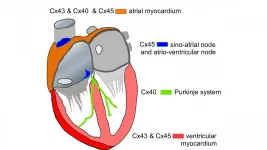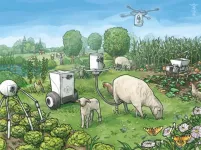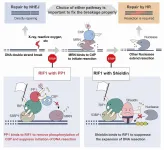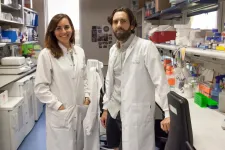(Press-News.org) Feeling extra sweaty from a summer heat wave? Don't worry--not all your perspiration has to go to waste. In a paper publishing July 13 in the journal Joule, researchers have developed a new device that harvests energy from the sweat on--of all places--your fingertips. To date, the device is the most efficient on-body energy harvester ever invented, producing 300 millijoules (mJ) of energy per square centimeter without any mechanical energy input during a 10-hour sleep and an additional 30 mJ of energy with a single press of a finger. The authors say the device represents a significant step forward for self-sustainable wearable electronics.
"Normally, you want maximum return on investment in energy. You don't want to expend a lot of energy through exercise to get only a little energy back," says senior author Joseph Wang (@JWangnano), a nanoengineering professor at the University of California San Diego. "But here, we wanted to create a device adapted to daily activity that requires almost no energy investment--you can completely forget about the device and go to sleep or do desk work like typing, yet still continue to generate energy. You can call it 'power from doing nothing.'"
Previous sweat-based energy devices required intense exercise, such as a great deal of running or biking, before the user sweated enough to activate power generation. But the large amount of energy consumed during exercise can easily cancel out the energy produced, often resulting in energy return on investment of less than 1%.
In contrast, this device falls into what the authors call the "holy grail" category of energy harvesters. Instead of relying on external, irregular sources like sunlight or movement, all it needs is finger contact to collect more than 300 mJ of energy during sleep--which the authors say is enough to power some small wearable electronics. Since no movement is needed, the ratio between harvested energy and invested energy is essentially infinite.
It may seem odd to choose fingertips as the source of this sweat over, say, the underarms, but in fact, fingertips have the highest concentration of sweat glands compared to anywhere else on the body.
"Generating more sweat at the fingers probably evolved to help us better grip things," says first co-author Lu Yin (@YinLu_CLT), a nanoengineering PhD student working in Wang's lab. "Sweat rates on the finger can reach as high as a few microliters per square centimeter per minute. This is significant compared to other locations on the body, where sweat rates are maybe two or three orders of magnitude smaller."
The device the researchers developed in this study is a type of energy harvester called a biofuel cell (BFC) and is powered by lactate, a dissolved compound in sweat. From the outside, it looks like a simple piece of foam connected to a circuit with electrodes, all of which is attached to the pad of a finger. The foam is made out of carbon nanotube material, and the device also contains a hydrogel that helps maximize sweat absorption.
"The size of the device is about 1 centimeter squared. Its material is flexible as well, so you don't need to worry about it being too rigid or feeling weird. You can comfortably wear it for an extended period of time," says Yin.
Within the device, a series of electrochemical reactions occur. The cells are equipped with a bioenzyme on the anode that oxidizes, or removes electrons from, the lactate; the cathode is deposited with a small amount of platinum to catalyze a reduction reaction that takes the electron to turn oxygen into water. Once this happens, electrons flow from the lactate through the circuit, creating a current of electricity. This process occurs spontaneously: as long as there is lactate, no additional energy is needed to kickstart the process.
Separate from but complementary to the BFC, piezoelectric generators--which convert mechanical energy into electricity--are also attached to the device to harvest up to 20% additional energy. Relying on the natural pinching motion of fingers or everyday motions like typing, these generators helped produce additional energy from barely any work: a single press of a finger once per hour required only 0.5 mJ of energy but produced over 30 mJ of energy, a 6,000% return in investment.
The researchers were able to use the device to power effective vitamin C- and sodium-sensing systems, and they are optimistic about improving the device to have even greater abilities in the future, which might make it suitable for health and wellness applications such as glucose meters for people with diabetes. "We want to make this device more tightly integrated in wearable forms, like gloves. We're also exploring the possibility of enabling wireless connection to mobile devices for extended continuous sensing," Yin says.
"There's a lot of exciting potential," says Wang. "We have ten fingers to play with."
INFORMATION:
This work was supported by the UCSD Center for Wearable Sensors.
Joule, Yin et al.: "A passive perspiration biofuel cell: High energy return on investment" https://www.cell.com/joule/fulltext/S2542-4351(21)00292-0
Joule (@Joule_CP), published monthly by Cell Press, is a home for outstanding and insightful research, analysis, and ideas addressing the need for more sustainable energy. A sister journal to Cell, Joule spans all scales of energy research, from fundamental laboratory research into energy conversion and storage up to impactful analysis at the global level. Visit http://www.cell.com/joule. To receive Cell Press media alerts, contact press@cell.com.
WASHINGTON, July 13, 2021 -- The rhythm in a working heart is regulated by electrical impulses. Disturbances of this bioelectrical process can result in cardiac arrhythmias, or irregularities in heartbeat -- a common ailment that can lead to illness and death.
In Biophysics Reviews, by AIP Publishing, researchers from Harvard Medical School provide a state-of-the-art update on how electrical impulses in the heart travel from cell to cell.
A functioning heart contracts to pump blood to the body and the lungs. Within the heart, a pacemaker acts as an electrical clock, sending out a signal that tells the heart when to contract. The whole muscle moves together, because ...
No longer science fiction, farm robots are already here--and they have created two possible extremes for the future of agriculture and its impacts on the environment, argues agricultural economist Thomas Daum in a Science & Society article published July 13 in the journal Trends in Ecology & Evolution. One is a utopia, where fleets of small, intelligent robots farm in harmony with nature to produce diverse, organic crops. The other is a dystopia in which large, tractor-like robots subdue the landscape through heavy machinery and artificial chemicals.
He describes the utopian scenario as a mosaic ...
PITTSBURGH, July 13, 2021 - Substantially more people in the U.S. with opioid use disorder are receiving evidence-based treatment for the disease, but there are still considerable gaps in care along racial lines, according to the largest analysis to date of opioid use disorder among Medicaid recipients.
The results, published today in JAMA, provide insights that policymakers and medical providers can act on to improve access to quality care for opioid use disorder, one of the leading causes of death in the U.S. The analysis was possible because of a unique network that partnered academic institutes with state Medicaid programs to overcome barriers to data sharing between states.
"Medicaid plays an incredibly important role in our ...
A new wearable device turns the touch of a finger into a source of power for small electronics and sensors. Engineers at the University of California San Diego developed a thin, flexible strip that can be worn on a fingertip and generate small amounts of electricity when a person's finger sweats or presses on it.
What's special about this sweat-fueled device is that it generates power even while the wearer is asleep or sitting still. This is potentially a big deal for the field of wearables because researchers have now figured out how to harness the energy that can be extracted from human sweat even when a person is not moving.
This type of device is ...
What The Study Did: Researchers used a large data resource of U.S. COVID-19 cases and control patients who tested negative from multiple health systems across the country to evaluate COVID-19 severity and risk factors over time and assess the use of machine learning to predict clinical severity.
Authors: Tellen D. Bennett, M.D., of the University of Colorado School of Medicine in Aurora, and Christopher G. Chute, M.D., of Johns Hopkins University in Baltimore, are corresponding authors.
To access the embargoed study: Visit our For The Media website at this link https://media.jamanetwork.com/
(doi:10.1001/jamanetworkopen.2021.16901)
Editor's Note: The article includes conflict of interest and funding/support disclosures. Please see the ...
Osaka, Japan - BRCA1, a protein that is well-known for its role in hereditary breast cancer, is an important part of the cellular system that repairs double-strand DNA breaks. Now, researchers from Japan have discovered a new way in which cells protect these broken DNA ends to make sure that they are repaired correctly.
In a study published in Cell Reports, researchers from Osaka University have revealed that protein phosphatase 1 (PP1) binds to double-strand breaks early on to promote repair by a process known as nonhomologous end joining instead of by homologous ...
For their own benefit and to grow beyond control, tumours manipulate cell signals to make it appear as if the cells have the nutrients they need. That is the case in follicular lymphoma, a type of tumour that affects the B lymphocytes of the immune system. One in six follicular lymphoma patients has mutations in RagC, a gene involved in the mTOR nutrient signalling pathway.
The team led by Alejo Efeyan, head of the Metabolism and Cell Signalling Group at the Spanish National Cancer Research Centre (CNIO), has discovered that genetic inhibition of the RagC protein blocks the activation of B lymphocytes and delays the onset of follicular lymphomas without side effects. The study, which was carried out in animal models, was published this ...
Patients with Achilles tendinopathy, a disease of the Achilles tendon that can potentially cause significant pain, receive no benefit from being treated with platelet rich plasma (PRP) injection, a clinical trial led by the University of Warwick has found.
PRP is a treatment often used for a number of orthopaedic conditions and popularised by its use by elite sportspeople. However, this new study published today (13 July) in the Journal of the American Medical Association and funded by Versus Arthritis has shown that it is ineffective for the treatment of Achilles tendinopathy ...
New research from the Institute of Psychiatry, Psychology & Neuroscience (IoPPN) at King's College London, in collaboration with Glasgow University, has found that teenagers who have self-harmed five or more times in their life have a significantly higher threshold for pain compared to adolescents that have not.
The study, which has been published in JAMA Network Open, is the largest study of its kind looking at the relationship between self-harm and bodily sensation, found that the threshold for sensitivity, both painful and not, increases significantly the more a participant ...
(Boston)--Proper lung function relies on the precise balance of specialized epithelial cells (cells that line the surfaces of the body) that coordinate functions to maintain homeostasis. One important lung cell type is the goblet cell, which secretes mucus that helps protect the lining of the bronchus (major air passages of the lung) and trap microorganisms. Goblet cells are often increased in lung diseases, but signals that lead to their dysregulation are not well understood.
Researchers have now discovered a new set of signals that control the production of goblet cells in the lung. "By altering the proteins that control these signals we are able to either increase or decrease the production of goblet cells which offers potential new avenues for therapeutically targeting ...




